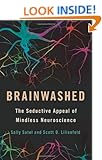 Responding to the backlash against materialist neuroscience, especially Brainwashed (pictured left), Gary Marcus warned in the New Yorker that neuroscientist will so be able to read minds one of these days:
Responding to the backlash against materialist neuroscience, especially Brainwashed (pictured left), Gary Marcus warned in the New Yorker that neuroscientist will so be able to read minds one of these days:
Just because a given activity or response is spread across the brain—involving many different regions rather just a single section—does not mean it is beyond understanding. It just means we need to work harder to discern its underlying principles. And already, in 2013, using tools that will seem antiquated in a decade, there has been considerable progress in accurately imaging the brain as a way to peek into the workings of the mind. Last summer, for example, Jack Gallant, at U.C. Berkeley, reported a study in which people watched movies while having their brain scanned. After the data was collected, Gallant’s team used complex mathematical techniques to analyze the brain scans. There was no single spot that lit up when people were watching a car chase as opposed to a conversation, but, by looking at the ensemble of brain activity, Gallant’s group at Berkeley could easily distinguish between the two. Over all, they were able to reconstruct, with surprising accuracy, which parts of the movie people were watching at a given time, based on analyses of the patterns of activity displayed across their entire brain.
It is reasonable to think, based on current research, that no single spot of the brain maps to hatred. But there is no principled reason to think that we will never be able to find some neural pattern, or set of patterns, that correspond to that emotion. Another group, in Europe, recently started to analyze emotion using techniques similar to Gallant’s; they found that it may be “possible to discriminate between healthy and depressed individuals based on differences in brain-wide responses to emotional cues.” A soon-to-be-published paper from Carnegie Mellon similarly suggests that emotions can be discerned using complex, whole-brain analyses.
At the time, I was tempted to respond, you could do just as well reading facial expressions, provided you are familiar with the culture. (Famously, even facial expressions are hard to read apart from culture.)
Well, I was wrong. This just in: In Boston Magazine, Shannon Fischer writes,
For half a century, one theory about the way we experience and express emotion has helped shape how we practice psychology, do police work, and even fight terrorism. But what if that theory is wrong?
More.
Forty-six years ago a young San Francisco–based cowboy of a psychologist named Paul Ekman emerged from the jungle with proof of a powerful idea. During the previous couple of years, he had set out trying to prove a theory popularized in the 19th century by Charles Darwin: that people of all ages and races, from all over the world, manifest emotions the same way. Ekman had traveled the globe with photographs that showed faces experiencing six basic emotions—happiness, sadness, fear, disgust, anger, and surprise. Everywhere he went, from Japan to Brazil to the remotest village of Papua New Guinea, he asked subjects to look at those faces and then to identify the emotions they saw on them. To do so, they had to pick from a set list of options presented to them by Ekman. The results were impressive. Everybody, it turned out, even preliterate Fore tribesmen in New Guinea who’d never seen a foreigner before in their lives, matched the same emotions to the same faces. Darwin, it seemed, had been right.
…
So began a meteoric rise to fame. Since that first article, Ekman has consulted for not only the CIA but also the FBI, the Department of Homeland Security, the New York Police Department, and the Transportation Security Administration, which has spent more than a billion dollars training its airport agents in techniques based on Ekman’s theories.
… But …
Barrett is a professor of psychology at Northeastern, and for years she’s been troubled by Ekman’s ideas. People don’t display and recognize emotions in universal ways, she believes, and emotions themselves don’t have their own places in the brain or their own patterns in the body. Instead, her research has led her to conclude that each of us constructs them in our own individual ways, from a diversity of sources: our internal sensations, our reactions to the environments we live in, our ever-evolving bodies of experience and learning, our cultures.
This may seem like nothing more than a semantic distinction. But it’s not. It’s a paradigm shift that has put Barrett on the front lines of one of the fiercest debates in the study of emotion today, because if Barrett is correct, we’ll need to rethink how we interpret mental illness, how we understand the mind and self, and even what psychology as a whole should become in the 21st century.
About time. And let’s start the Big Chuck with evo psych.
Note: Yes, there is such a thing as mental illness, but much standard classification is in tatters, and any new paradigm that works will not be a materialist one.
Hat tip: Stephanie West Allen at Brains on Purpose
See also: Materialists respond to backlash against materialist neuroscience